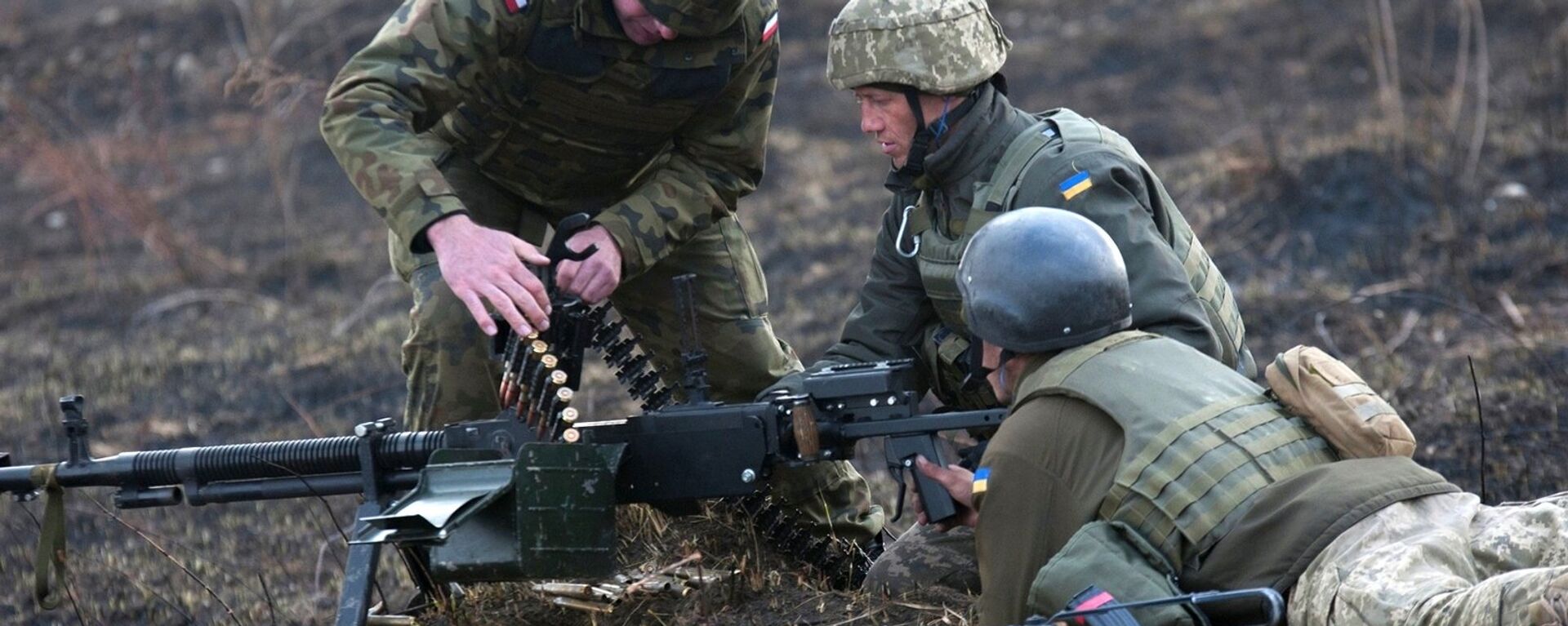https://sputnikglobe.com/20230630/more-evidence-shows-use-of-banned-landmines-by-ukrainian-forces---human-rights-watch-1111579536.html
More Evidence Shows Use of Banned Landmines by Ukrainian Forces - Human Rights Watch
More Evidence Shows Use of Banned Landmines by Ukrainian Forces - Human Rights Watch
Sputnik International
The Human Rights Watch has urged the Ukrainian government to comply with the 1997 Mine Ban Treaty and to investigate its armed forces for using internationally banned antipersonnel landmines.
2023-06-30T19:25+0000
2023-06-30T19:25+0000
2023-10-21T13:00+0000
russia's special operation in ukraine
steve goose
ukraine
russia
geneva
human rights watch
the united nations (un)
amnesty international
viral
https://cdn1.img.sputnikglobe.com/img/07e7/01/1f/1106865471_0:309:3050:2025_1920x0_80_0_0_5906844eaebf325fd20daeb3feebee92.jpg
A new report by the HRW has added another dimension to allegations of Ukrainian forces' use of prohibited landmines in its conflict with Russia. "Since publishing a report in January, Human Rights Watch has uncovered additional evidence regarding Ukrainian use of these indiscriminate weapons during 2022," the report said.Earlier, in a statement published by the HRW in January, the Ukrainian army was accused of repeatedly shooting rockets bearing thousands of PFM-1 mines - also known as "petal" or "butterfly" mines - into Russian territory between April and September 2022, leading to civilian casualties.Despite being a signatory to the Mine Ban Treaty in Geneva, the HRW cites evidence of Kiev forces using PFM-1S antipersonnel mines, resulting in civilian casualties. The deployment of prohibited landmines by Ukrainian forces underscores the potential for atrocities in the heat of the conflict.Ukraine, following the Soviet Union's disintegration, found itself possessing a vast arsenal of antipersonnel mines. Kiev successfully eliminated over 3.4 million of the devices between 1999 and 2020, having signed the Anti-Personnel Mine Ban Convention on February 24, 1999, and ratifying it on December 27, 2005. As of 2021, according to official Ukrainian reports to the UN, approximately 3.3 million PFM mines, primarily housed in 9M27K3 220mm rockets, have yet to be destroyed. Unfortunately, in the light of past instances, as recorded by Human Rights Watch in May 2023, the accounts of an individual working in Izium, Kharkov region, eastern Ukraine, found several artillery shells while clearing farmland. Close inspection of the shells revealed identifiable markings - 9N128K3 warhead portions of 9M27K3 Uragan 220mm rockets, which each carries 9N223 “blocks,” or stacks, of 9N212 PFM-1S antipersonnel blast mines manufactured in 1986. The finding corroborates the culpability of Ukrainian forces in violating the Mine Ban Treaty. The mines are known to be hazardous as they can be dispersed en masse through rockets. Their small and harmless appearance has historically led to severe injuries among unsuspecting civilians, including children.As per an Amnesty International report in August 2022, Ukrainian armed forces have been implicated in jeopardizing civilian lives by positioning bases and deploying weapon systems within inhabited residential zones, including schools and hospitals, in their response to Russian advantages in firepower. The controversial approach infringes upon international humanitarian law as it converts non-military structures into possible military targets. In 19 various towns and villages, Ukrainian forces were found operating from within civilian areas and utilizing civilian infrastructure for military purposes. The alarming trend was substantiated by Amnesty's Crisis Evidence Lab, which used satellite imagery analysis to confirm multiple instances of such tactics.
https://sputnikglobe.com/20220830/eu-hatched-ukrainian-army-training-mission-idea-long-before-escalation-of-conflict-borrell-admits-1100168402.html
ukraine
russia
geneva
Sputnik International
feedback@sputniknews.com
+74956456601
MIA „Rosiya Segodnya“
2023
Chimauchem Nwosu
https://cdn1.img.sputnikglobe.com/img/07e7/09/01/1113046371_0:99:1536:1635_100x100_80_0_0_9c5c627283eca931c39fe4852bbb301c.jpg
Chimauchem Nwosu
https://cdn1.img.sputnikglobe.com/img/07e7/09/01/1113046371_0:99:1536:1635_100x100_80_0_0_9c5c627283eca931c39fe4852bbb301c.jpg
News
en_EN
Sputnik International
feedback@sputniknews.com
+74956456601
MIA „Rosiya Segodnya“
Sputnik International
feedback@sputniknews.com
+74956456601
MIA „Rosiya Segodnya“
Chimauchem Nwosu
https://cdn1.img.sputnikglobe.com/img/07e7/09/01/1113046371_0:99:1536:1635_100x100_80_0_0_9c5c627283eca931c39fe4852bbb301c.jpg
human rights watch, hrw, russia-ukraine conflict, ukrainian armed forces, mine ban treaty, pfm-1s mines, ukrainian army, russian territory, soviet union, antipersonnel mines, ukraine, anti-personnel mine ban convention, pfm mines, volodymyr zelensky regime, steve goose, izyum, kharkiv, eastern ukraine, 9n128k3 warhead, 9m27k3 uragan 220mm rockets, 9n223, 9n212 pfm-1s, antipersonnel blast mines, ukrainian forces, amnesty international, international humanitarian law, amnesty's crisis evidence lab, agnès callamard, amnesty international’s secretary general
human rights watch, hrw, russia-ukraine conflict, ukrainian armed forces, mine ban treaty, pfm-1s mines, ukrainian army, russian territory, soviet union, antipersonnel mines, ukraine, anti-personnel mine ban convention, pfm mines, volodymyr zelensky regime, steve goose, izyum, kharkiv, eastern ukraine, 9n128k3 warhead, 9m27k3 uragan 220mm rockets, 9n223, 9n212 pfm-1s, antipersonnel blast mines, ukrainian forces, amnesty international, international humanitarian law, amnesty's crisis evidence lab, agnès callamard, amnesty international’s secretary general
More Evidence Shows Use of Banned Landmines by Ukrainian Forces - Human Rights Watch
19:25 GMT 30.06.2023 (Updated: 13:00 GMT 21.10.2023) Human Rights Watch (HRW) has urged the Ukrainian government to comply with the 1997 Mine Ban Treaty and to investigate its armed forces for using internationally banned antipersonnel landmines.
A new
report by the HRW has added another dimension to allegations of Ukrainian forces' use of prohibited landmines in its conflict with Russia.
"Since publishing a report in January, Human Rights Watch has uncovered additional evidence regarding Ukrainian use of these indiscriminate weapons during 2022," the report said.
Earlier, in a
statement published by the HRW in January, the Ukrainian army was accused of repeatedly shooting rockets bearing thousands of PFM-1 mines - also known as "petal" or "butterfly" mines - into Russian territory between April and September 2022, leading to civilian casualties.
Despite being a signatory to the Mine Ban Treaty in Geneva, the HRW cites evidence of Kiev forces using PFM-1S antipersonnel mines, resulting in civilian casualties. The deployment of prohibited landmines by Ukrainian forces underscores the potential for atrocities in the heat of the conflict.
Ukraine, following the Soviet Union's disintegration, found itself possessing a vast arsenal of antipersonnel mines. Kiev successfully
eliminated over 3.4 million of the devices between 1999 and 2020, having signed the Anti-Personnel Mine Ban Convention on February 24, 1999, and ratifying it on December 27, 2005. As of 2021, according to official Ukrainian
reports to the UN, approximately 3.3 million PFM mines, primarily housed in 9M27K3 220mm rockets, have yet to be destroyed.
“The Ukrainian government’s pledge to investigate its military’s apparent use of banned antipersonnel mines is an important recognition of its duty to protect civilians,” said Steve Goose, arms director at Human Rights Watch.

30 August 2022, 11:00 GMT
Unfortunately, in the light of past instances, as recorded by Human Rights Watch in May 2023, the
accounts of an individual working in Izium, Kharkov region, eastern Ukraine, found several artillery shells while clearing farmland.
Close inspection of the shells revealed identifiable markings - 9N128K3 warhead portions of 9M27K3 Uragan 220mm rockets, which each carries 9N223 “blocks,” or stacks, of 9N212 PFM-1S antipersonnel blast mines manufactured in 1986. The finding corroborates the culpability of Ukrainian forces in violating the Mine Ban Treaty.
The mines are known to be hazardous as they can be dispersed en masse through rockets. Their small and harmless appearance has historically led to severe injuries among unsuspecting civilians, including children.
“We are deeply concerned by this documented use from a longstanding member state to the Mine Ban Treaty,” said ICBL-CMC Director Hector Guerra.
As per an
Amnesty International report in August 2022, Ukrainian armed forces have been implicated in jeopardizing civilian lives by positioning bases and deploying weapon systems within inhabited residential zones, including schools and hospitals, in their response to Russian advantages in firepower.
The controversial approach infringes upon international humanitarian law as it converts non-military structures into possible military targets. In 19 various towns and villages, Ukrainian forces were found operating from within civilian areas and utilizing civilian infrastructure for military purposes. The alarming trend was substantiated by Amnesty's Crisis Evidence Lab, which used satellite imagery analysis to confirm multiple instances of such tactics.
“We have documented a pattern of Ukrainian forces putting civilians at risk and violating the laws of war when they operate in populated areas,” Agnès Callamard, Amnesty International’s secretary general, noted at the time.






